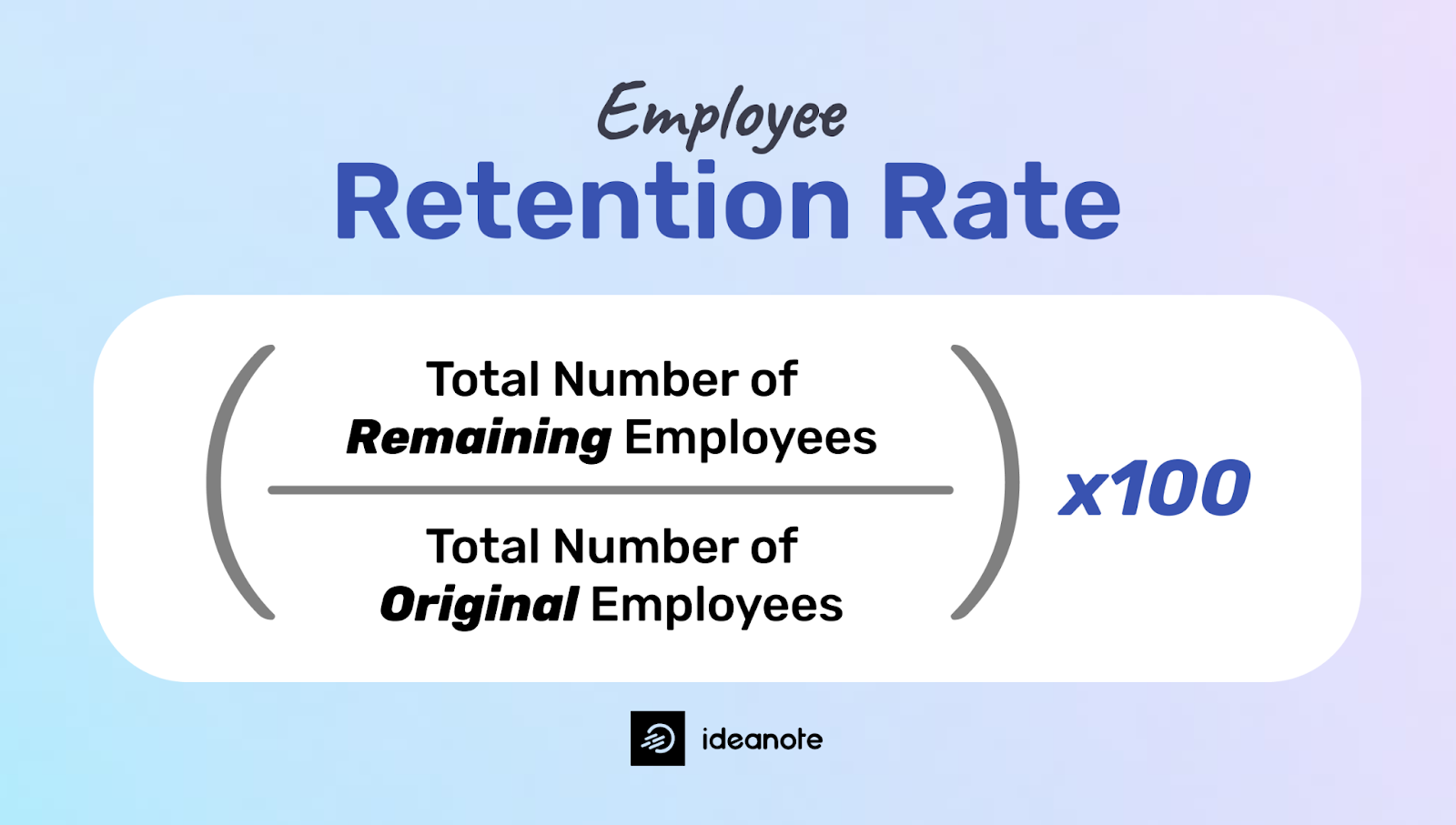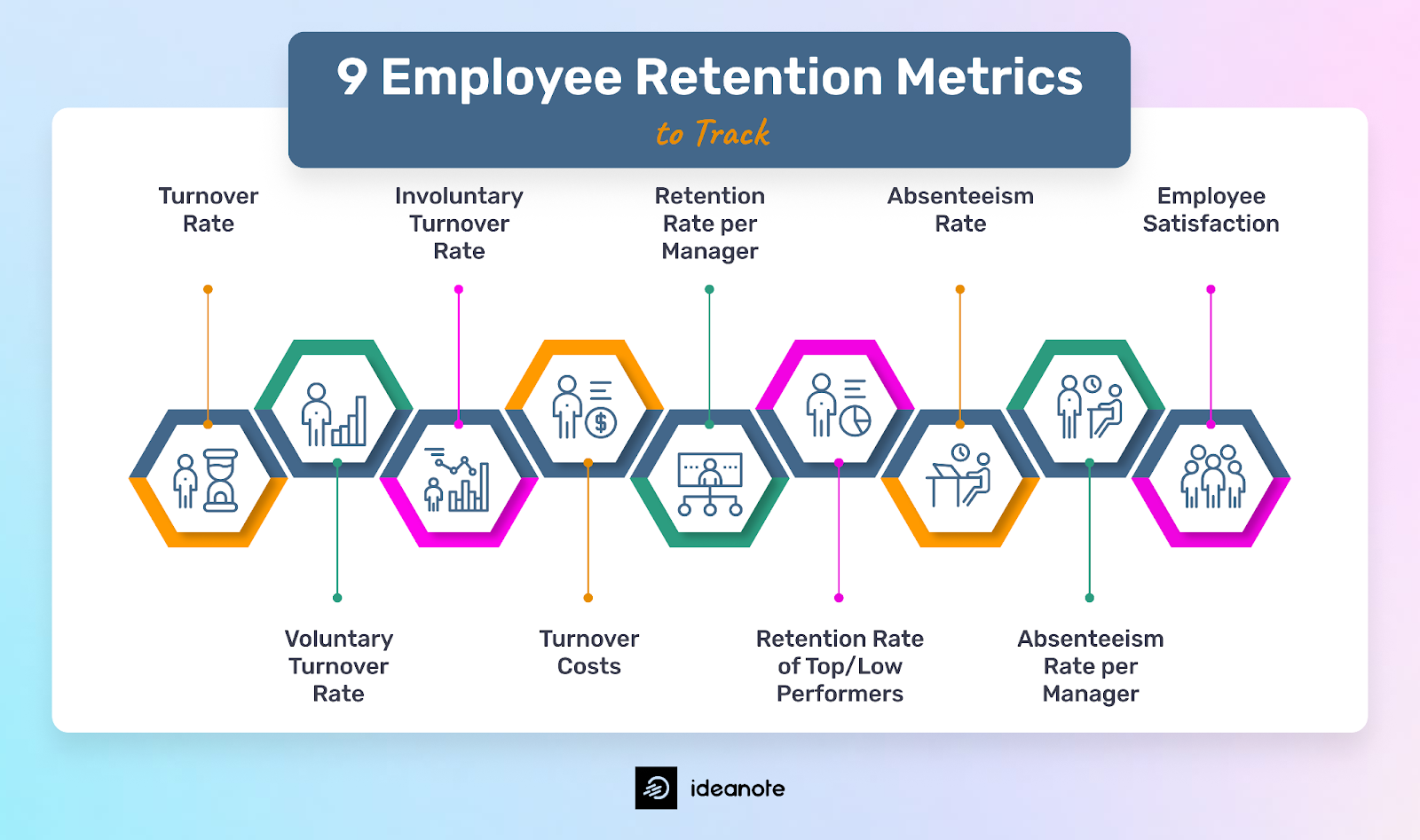Employee Retention Rate: Definition, Formula & Metrics
We’ll discuss what an employee retention rate is, how to calculate it, and what other metrics you should monitor to prevent retention issues.

Attracting skilled employees to work at your company is one thing, but your ability to keep them with the company is another. In fact, good employee retention is one of the key components of success for any company.
If you can’t retain your employees, all the effort and resources invested in recruiting and training them may go to waste. Even worse, a high turnover rate can cost your company a lot of money. Studies show that the cost of replacing an individual employee can vary from half to twice their annual salary.
So, companies should keep an eye on their employee retention and measure it periodically to prevent losing top talent.
In this article, we’ll discuss what an employee retention rate is, how to calculate it, and what other metrics you should monitor to prevent retention issues.
What Does Employee Retention Rate Mean?
Simply put, employee retention rate is the percentage of employees who have stayed with your company over a given period.
More specifically, it’s the ratio between the number of employees who remain with the company at the end of a specific period and the total number of employees at the start of that period, expressed as a percentage.
A high retention rate means employees are satisfied with their jobs and the workplace enough not to consider leaving. However, it does not necessarily imply that employees are engaged - it merely shows that they have chosen to stay with the company rather than seek opportunities elsewhere.
On the other hand, a low employee retention rate indicates an issue with employee engagement and satisfaction. A study by the Pew Research Center found that 63% of surveyed employees quit their jobs because of low pay and a lack of growth opportunities.

Why Is It Important to Know Your Employee Retention Rate
Keeping an eye on your employee retention rate is key to helping you prevent a retention crisis before it happens.
Unless you’re keeping your hand on the pulse, it’s easy not to notice when your employee engagement and satisfaction start dropping, and they begin to leave the company at scale.
What Is a Good Employee Retention Rate
Achieving a 100% retention rate is simply impossible. No matter how great a workplace you’ve created for your employees, some will always leave. Still, you should aim for the highest possible retention rate. The closer to 100%, the better!
Typically, 90% is considered a good average employee retention rate, but keep in mind that it can vary significantly depending on your industry.
Plus, sometimes, a slightly lower retention rate may not be a bad thing - for example, if you haven’t made good hiring decisions and are stuck with employees who aren’t contributing to your company's success.
In that case, you’d want these employees to leave so they can make room for more engaged employees who can perform better.
How to Calculate Your Employee Retention Rate
The formula to calculate your employee retention rate is pretty simple. Here it is:
Employee retention rate = (Number of employees at the end of a specific period / Number of total employees at the start of that period) * 100
For example, let's say you had 150 employees at the beginning of the year and 140 employees at the end of the year. Plugging these numbers into the formula:
Retention rate = (140 / 150) * 100 = 93.33%
So, your employee retention rate for the year would be 93.33%. This means 93.33% of your employees stayed with the company over the specified period. Conversely, your turnover rate for the year is 6.67%. That’s great!
9 Employee Retention Metrics to Track
While employee retention rate is the main metric to track to help you prevent retention issues, it’s not the only one you should monitor.
Here are 9 other retention metrics that can help you assess and improve employee retention.

Turnover Rate
The turnover rate is essentially the opposite of the retention rate. While the retention rate shows you the percentage of employees who stayed with your company over a given period, the turnover rate shows you the percentage of those who left - either voluntarily or involuntarily.
Here’s the formula:
Employee turnover rate = (Number of employees who left over a specific period/Number of total employees at the beginning of that period)*100.
So, if you had 200 employees at the beginning of the year, and by the end of the year, 30 employees had left the company for various reasons, your turnover rate for that year would be 15%.
Voluntary Turnover Rate
The voluntary turnover rate is the percentage of employees who left your company over a given period by their own decision. If your voluntary turnover rate is high, it means that a significant portion of your workforce is choosing to leave the company voluntarily.
This could indicate various underlying issues within the workplace, such as general employee dissatisfaction, lack of career growth opportunities, bad management, or poor company culture.
Involuntary Turnover Rate
Conversely, the involuntary turnover rate is the percentage of employees who were fired from your company over a given period.
A high involuntary turnover rate typically indicates that you didn’t make great hiring choices to begin with.
It can also mean that a large number of employees became disengaged, which led to a significant decline in their productivity and performance.
Turnover Costs
A high turnover rate translates into higher costs for the company. When your employees leave, you must pay severance and hire and train new employees, not to mention all the money you lose due to a decrease in productivity while the position is left unfilled.
These costs are referred to as "turnover costs," and calculating them can help you figure out the financial impact of employee turnover on your company.
You can calculate your annual turnover cost by adding up all costs associated with turnover and dividing this number by the number of employees times your annual turnover rate.
Retention Rate per Manager
Calculating the overall retention rate for your company can help you gauge the effectiveness of your retention strategies and your ability to retain employees.
But if you want to see exactly which teams have the lowest turnover, you can calculate the retention rate per manager.
This metric shows the percentage of employees who stayed with your company over a given period, working under a specific manager.
Retention Rate of Top/Low Performers
The general employee retention rate shows you the percentage of employees who leave your company, but it doesn’t show you which type of employees are more likely to stay or leave.
If the top performers tend to leave faster than low performance, you’ll eventually have a serious problem with maintaining productivity, innovation, and overall performance within your organization.
Absenteeism Rate
Unhappy and disengaged employees tend to have more absences than engaged employees.
According to research by Gallup, disengaged employees have 37% higher absenteeism than engaged employees.
The absenteeism rate only accounts for unplanned absences like sickness or other unexpected reasons. It doesn’t count vacation or other planned absent time.
An increasing absenteeism rate can indicate that employees are becoming disengaged and closer to leaving the company.
Absenteeism Rate per Manager
The overall absence rate only shows you the percentage of employees who are absent from work for unplanned reasons.
If you want more specific insight into which teams or groups of employees tend to be more absent, you can calculate the absence rate per manager.
This metric shows you the percentage of unplanned absences among employees who report to a specific manager or team leader.
Identifying discrepancies in absence rates per manager allows you to address potential issues related to leadership, communication, or work environment that may be contributing to higher absenteeism.
Employee Satisfaction
Satisfied employees are 77% more likely to stay with the company. Conversely, employees who are unhappy and unsatisfied are much more likely to leave.
In fact, keeping your employees satisfied can lead to higher employee engagement, which, in turn, can prevent high employee turnover.
While employee satisfaction isn’t a tangible metric to measure, you can gauge the overall satisfaction levels with methods like employee satisfaction surveys, 1:1 interviews with employees, and eNPS scores.
Ready to Retain Top Talent?
If you're looking for an all-in-one solution for your innovation, look no further than Ideanote! With our flexible platform you can do everything from collecting ideas, engaging your crowd and analyzing your innovation performance.



























